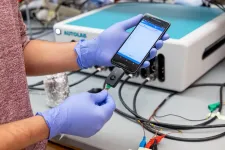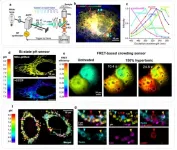(Press-News.org) BOSTON - (May 12, 2021) - Scientists are rapidly gathering evidence that variants of gut microbiomes, the collections of bacteria and other microbes in our digestive systems, may play harmful roles in diabetes and other diseases. Now Joslin Diabetes Center scientists have found dramatic differences between gut microbiomes from ancient North American peoples and modern microbiomes, offering new evidence on how these microbes may evolve with different diets.
The scientists analyzed microbial DNA found in indigenous human paleofeces (desiccated excrement) from unusually dry caves in Utah and northern Mexico with extremely high levels of genomic sequencing, says Joslin Assistant Investigator Aleksandar Kostic, PhD, senior author of a Nature paper presenting the work.
Performing genomic analysis more broadly and deeply than previous studies on ancient human gut microbiomes, the study was the first to reveal novel species of microbes in the specimens, says Kostic, who is also an Assistant Professor of Microbiology at Harvard Medical School.
In previous studies of children in Finland and Russia, Kostic and his colleagues showed that children in industrialized regions, who were much more likely to develop type 1 diabetes than those in non-industrialized areas, also had very different gut microbiomes. "We were able to identify specific microbes and microbial products that we believe hampered a proper immune education in early life," Kostic says. "And this leads later on to higher incidents of not just type 1 diabetes, but other autoimmune and allergic diseases."
So what would a healthy human microbiome look like before the effects of industrialization? "I'm convinced that you can't answer that question with any modern living people," says Kostic, who points that even tribes in extremely remote regions of the Amazon are contracting Covid-19.
Steven LeBlanc, an archeologist formerly with Harvard's Peabody Museum of Archaeology and Ethnology, came to Kostic with a dramatic alternative source: microbial DNA found in human paleofeces samples that museums have collected from arid environments in the North American Southwest.
Kostic and graduate student Marsha Wibowo took on the challenge, eventually comparing the DNA from eight exceptionally well-preserved ancient gut samples from dry caves (some dated as early as the first century of the current era) with DNA in 789 modern samples. Slightly more than half of the modern samples were from people on industrialized "Western" diets and the remainder from people consuming non-industrialized foods (grown mostly within their own communities).
The differences between microbiome populations were striking. For instance, a bacteria known as Treponema succinifaciens "is not in a single Western microbiome that we analyzed, but it's in every single one of the eight ancient microbiomes," Kostic says. The ancient microbiomes did match up more closely with modern non-industry microbiomes.
Strikingly, Wibowo found that almost 40% of the ancient microbial species had never been seen before. What might explain this high genetic variability?
"In ancient cultures, the foods you're eating are very diverse and can support a more eclectic collection of microbes," Kostic speculates. "But as you move toward industrialization and more of a grocery-store diet, you lose a lot of nutrients that help to support a more diverse microbiome."
The ancient microbiomes also had relatively higher numbers than the modern industrial microbiomes of transposases (transposable elements of DNA sequences that can change location in the genome).
"We think this could be a strategy for the microbes to adapt in an environment that shifts a lot more than the modern industrialized microbiome, where we eat the same things and live the same life more or less year-round," Kostic says. "Whereas in a more traditional environment, things change and microbes need to adapt. They might use this much larger collection of transposases to grab and collect genes that will help them adapt to the different environments."
Moreover, the ancient microbial populations incorporated fewer genes related to antibiotic resistance. The ancient samples also featured lower numbers of genes that produce proteins that degrade the intestinal mucus layer, which then can produce inflammation that is linked with various diseases.
Additionally, the work may shed light on a scientific controversy about whether populations of gut microbes are transmitted vertically from generation to generation of humans, or evolve primarily from surrounding environments.
Looking at the lineage of the common bacteria Methanobrevibacter smithii in the ancient samples, they found its evolution was consistent with a shared ancestral strain that has been dated to roughly when humans first migrated across the Bering Strait into North America. "These microbes, just like our own genomes, have been traveling with us," Kostic says.
The research project began with the need to identify uncontaminated human paleofeces samples that were preserved in unusually good condition. "When we reconstructed these genomes, we tried to be very conservative," Wibowo says.
In addition to carbon-14 dating, the scientists used dietary analyses and other methods to validate that the selected samples were indeed human and not contaminated by soil or by other animals such as dogs, she says. The investigators also confirmed that the chosen samples displayed the patterns of decay that all DNA is known to exhibit over time.
The team performed far deeper sequencing of DNA than what was achieved in previous efforts, at least 100 million reads, with 400 million reads of DNA for one specimen.
One collaborator, anthropologist Meradeth Snow, PhD, of the University of Montana at Missoula, led an initiative to get perspectives on the work from Native American Indigenous communities in the Southwest region. "We acknowledge and appreciate those individuals whose genetics and microbes were analyzed for this research, as well as present-day individuals with associated genetic or cultural heritage," the study emphasizes.
The researchers plan to expand their studies to many other ancient microbiome specimens, aiming to detect novel microbial species and trying to predict their metabolic functions. Kostic is intrigued by the possibility of resurrecting these ancient microbes in the lab, by inserting ancient genomes in the closest living bacterial species. "If we can grow them in the lab, we can understand the physiology of these microbes much, much better," he says.
LeBlanc helped the Joslin investigators gathered collaborators, eventually recruited from a dozen institutions. Among key contributions, Montana's Dr. Snow led the extraction and preparation of the ancient DNA, and Harvard's Christina Warinner, PhD, offered her expertise on the ancient human microbiome. "It's been amazing to learn from all of these brilliant collaborators," Wibowo says. "It really takes a village."
INFORMATION:
Joslin's Zhen Yang, Braden Tierney, Samuel Zimmerman and Jacob Luber were co-authors on the paper. So were Maxime Borry and Alexander Hübner of the Max Planck Institute; Kun Huang, Omar Rota-Stabelli and Nicola Segata of the University of Trento; Francisco Barajas-Olmos , Cecilia Contreras-Cubas, Humberto García-Ortiz, Angélica Martínez-Hernández and Lorena Orozco of the Mexican National Institute of Genomic Medicine; Philipp Kirstahler and Sünje Johanna Pamp of the Technical University of Denmark; Tre Blohm of the University of Montana; Francis Smiley of Northern Arizona University; Richard Arnold of the Pahrump Paiute Tribe and Consolidated Group of Tribes and Organizations; Sonia Ballal of Boston Children's Hospital; Julia Russ and Karl Reinhard of the University of Nebraska in Lincoln; and Frank Maixner of the Institute for Mummy Studies in Italy.
Lead support came from the American Diabetes Association, the Smith Family Foundation and the American Heart Association.
Surface plasmon polaritons (SPPs) are highly localized surface waves on the interface between metal and dielectric in the optical frequency band. SSPs do not naturally exist in the microwave and terahertz frequencies, so "spoof" surface plasmon polaritons (SSPPs) are necessary for operations in those lower frequency bands.
Like optical SPPs, microwave SSPPs exhibit highly localized electromagnetic fields, subwavelength resolution, and extraordinary field confinement. Therefore, SSPP transmission lines (TLs) have been proposed as novel types of microwaveguides that offer new solutions for miniaturization, ...
BOSTON - During the development and progression of Alzheimer's disease, a protein called tau accumulates and spreads in the brain. Understanding the mechanisms behind tau spread--and its consequences--may point to new prevention and treatment strategies for Alzheimer's disease and other forms of dementia. New insights now come from research that was led by investigators at Massachusetts General Hospital (MGH) and involves an anesthetic known to affect cognitive function. The findings are published in Communications Biology.
The scientists note that inflammation plays an important role in Alzheimer's disease, and microglia--immune cells that reside in the brain--are thought to be involved in this process by producing an ...
Since the discovery of Alzheimer's disease over a century ago, two hallmarks of the devastating illness have taken center stage.
The first, known as amyloid plaques, are dense accumulations of misfolded amyloid protein, occurring in the spaces between nerve cells. Most efforts to halt the advance of Alzheimer's disease have targeted amyloid protein plaques. To date, all have met dispiriting failure.
The second classic trait has, until recently, received less scrutiny. It consists of string-like formations within the bodies of neurons, produced by another crucial protein-- tau. These are known as neurofibrillary tangles.
In a new study, researchers with the ASU-Banner Neurodegenerative Disease Center at the Biodesign ...
PHILADELPHIA--A low-cost, rapid diagnostic test for COVID-19 developed by Penn Medicine provides COVID-19 results within four minutes with 90 percent accuracy. A paper published this week in Matter details the fast and inexpensive diagnostic test, called RAPID 1.0 (Real-time Accurate Portable Impedimetric Detection prototype 1.0). Compared to existing methods for COVID-19 detection, RAPID is inexpensive and highly scalable, allowing the production of millions of units per week.
Despite the urgency of the pandemic, most available methods for COVID-19 testing use RT-PCR--reverse transcription polymerase chain reaction--to detect ...
Central to any technological progress is the enrichment of human life. The internet and wireless connectivity have done that by allowing not only virtually anyone anywhere to connect real time, but by making possible connections between humans and a range of intelligent devices both indoors and outdoors, putting smart cities on the horizon.
One key aspect of realizing smart cities is "smart vehicles", the latest development in intelligent transportation systems (ITS), which involve the integration of communication, mapping, positioning, network, and sensor technologies to ensure cooperative, efficient, intelligent, safe, and economical transportation.
For decades, research on bringing to the streets smart vehicles that operate ...
The field of magnonics offers a new type of low-power information processing, in which magnons, the quanta of spin waves, carry and process data instead of electrons. The end goal of this field is to create magnonic circuits, which would be smaller and more energy-efficient than current electronic ones.
Until recently, the development of a functional magnonic device could take years of trial-and-error. Researchers from the University of Vienna and the TU Kaiserslautern have developed a new computational method to design new devices in a considerably shorter time. Moreover, the efficiency added through this novel inverse design method helps overcome a traditional problem with such devices: they were just suitable for one function only. Now, thanks to the proposed ...
The inhibition of pathological protein-protein interactions is a promising approach for treating a large number of diseases, including many forms of cancer. A team of researchers has now developed a bicyclic peptide that binds to beta-catenin--a protein associated with certain types of tumor. The secret of their success is the cyclic nature and the hairpin shape of the peptide, which mimics a natural protein structure, they report in the journal Angewandte Chemie.
Because of the extensive protein regions involved in protein-protein interactions, therapeutic approaches involving small molecules are often unsuccessful. Protein mimetics are alternatives that imitate the spatial structure of binding segments of natural protein binding partners. ...
In a new study from Lund University and the University of Gothenburg, patients were interviewed about their experiences ten years after undergoing obesity surgery. The results show that the effect on eating and weight regulation persisted, whereas other problems, such as feelings of guilt about still not being healthy enough, remained.
"This is one of few follow-ups from a patients perspective so long after surgery", says My Engström, researcher in nursing at the University of Gothenburg.
18 patients were interviewed in the study. All of them experienced that their eating habits and appetite were still affected after the operation: their bodies still objected, preventing ...
Mycobacterium tuberculosis is incredible in that it can survive for decades within its human host. It does this by varying its diet to successfully steal nutrients from the human host including immune cells; it is known to acquire and absorb multiple carbon sources from the body during infection.
In a paper published in the journal Molecular Systems Biology, Surrey scientists detail how they measure the flow of metabolites or "fluxes" through metabolic pathways when Mycobacterium tuberculosis is consuming some of its favourite nutrients. Measuring these 'fluxes' could help scientists advance new tuberculosis drugs as well as understand why the bacterium survives so long in humans and why current antibiotics are often ineffective.
By growing Mycobacterium ...
The multiplexing capability of fluorescence microscopy is severely limited by the broad fluorescence spectral width. Spectral imaging offers potential solutions, yet typical approaches to disperse the local emission spectra notably impede the attainable throughput and place substantial constraints on temporal resolution. Tunable bandpass filters provide a possibility to scan through the emission wavelength in the wide field. However, applying narrow bandpasses to the fluorescence emission results in inefficient use of the scarce signal.
In a new paper published in Light: Science & Application, a team of scientists, led by Professor Ke Xu ...





